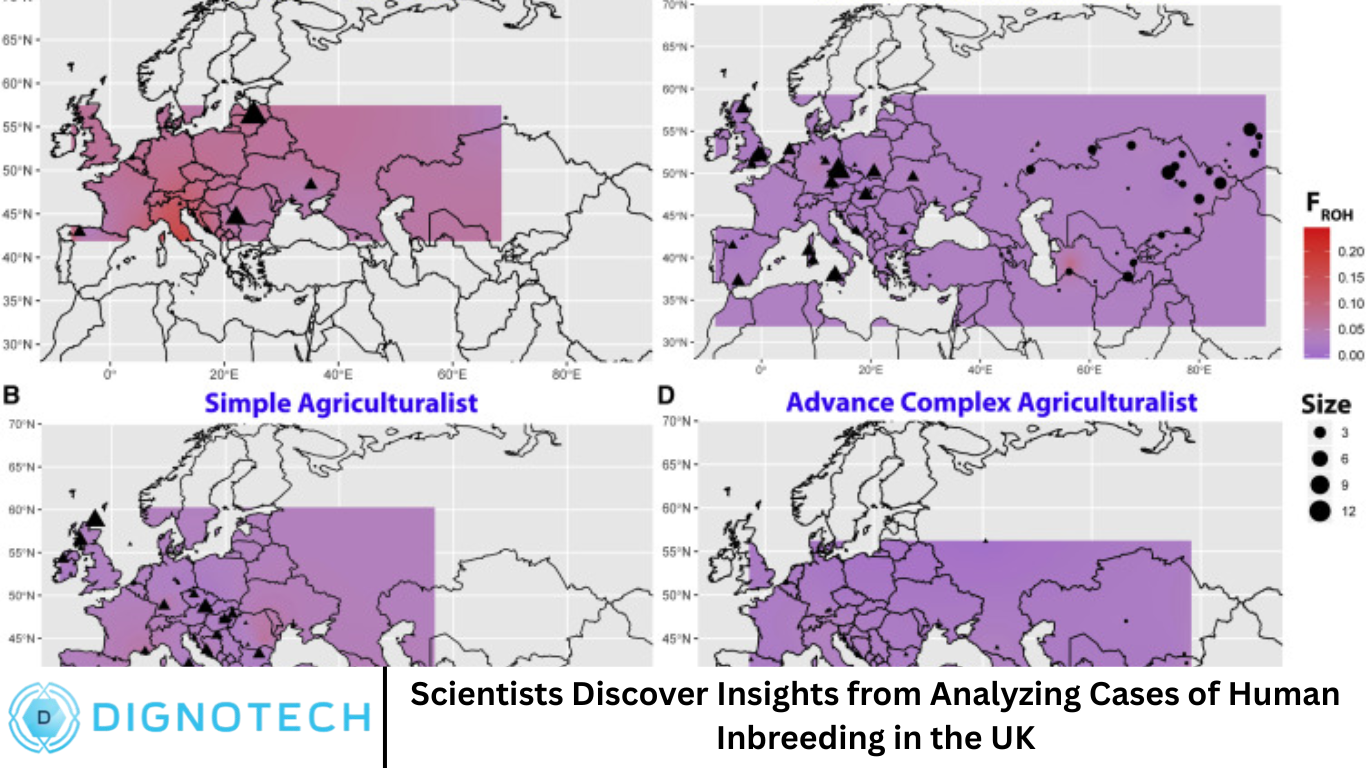Scientists Discover Insights from Analyzing Cases of Human Inbreeding in the UK

Human inbreeding has been a subject of interest and concern for scientists and ethicists alike. The idea of genetic isolation within families has been linked to increased risks of genetic disorders and reduced genetic diversity, which in turn can result in significant health issues. In the UK, a recent study analyzing cases of human inbreeding has provided new insights into the potential risks, consequences, and historical significance of inbreeding. This article delves into these findings, highlighting the importance of understanding inbreeding in human populations and how it impacts genetic health.
Introduction
Inbreeding is the reproduction between individuals who are closely related genetically, such as between siblings or between cousins. While it may be a natural occurrence in certain species, in humans, it is generally considered taboo and is associated with numerous negative consequences for health and well-being. Inbreeding increases the likelihood of genetic mutations being passed down through generations, which can lead to congenital disorders, developmental issues, and other severe health problems.
For years, scientists have been studying the effects of inbreeding on human populations, particularly in isolated communities where marriage between close relatives may be more common. The recent study of human inbreeding cases in the UK provides a comprehensive analysis of the genetic consequences of inbreeding in modern human populations.
The Study: Methods and Objectives
The study was conducted by a team of geneticists, anthropologists, and epidemiologists who sought to understand the implications of inbreeding in the UK. They analyzed records of individuals from different regions of the country, focusing on both historical and contemporary cases of inbreeding. The team used a variety of research methods, including genetic sequencing, family history analysis, and public health records, to gather data on inbreeding cases.
The primary objectives of the study were to:
- Assess the prevalence of inbreeding in the UK – How common is inbreeding in modern-day Britain?
- Examine the genetic consequences – What are the health risks associated with inbreeding on a genetic level?
- Understand historical patterns of inbreeding – How has inbreeding been practiced historically, and what impact has it had on the health of the population?
- Identify regions with higher rates of inbreeding – Are there geographic areas where inbreeding is more common, and if so, why?
- Explore the social and cultural factors – What cultural and social factors influence inbreeding in contemporary UK society?
By addressing these questions, the researchers hoped to gain a better understanding of the genetic and societal factors at play in cases of human inbreeding.
Prevalence of Inbreeding in the UK
Inbreeding is often viewed as a phenomenon that occurs in isolated or rural communities where social mobility is limited. However, the study found that while cases of close-relative marriage have decreased over the years, inbreeding still persists in certain parts of the UK, albeit at lower rates than in the past.
Historically, certain regions of the UK—such as rural areas and isolated island communities—had higher rates of inbreeding due to geographic isolation and a limited pool of marriageable individuals. In these communities, the practice of marrying within extended families or clans was more common, often due to social or economic constraints. In some cases, these practices were driven by the need to preserve family wealth, land, or power within a specific lineage.
Today, the rates of inbreeding have significantly decreased, thanks in part to improved transportation, communication, and social integration. However, certain ethnic groups or communities with small populations and limited genetic diversity still face a higher risk of inbreeding. This is particularly true for certain groups with cultural practices or traditions that encourage marrying within specific families or clans.
Genetic Consequences of Inbreeding
One of the key findings of the study was the significant genetic consequences associated with inbreeding. Inbreeding increases the likelihood that harmful recessive genetic mutations, which are usually masked in a population with greater genetic diversity, will be expressed in offspring. This occurs because closely related individuals share a higher proportion of the same genetic material, which increases the chances of both parents carrying the same harmful mutations.
The study highlighted several key health risks associated with inbreeding:
- Increased Risk of Genetic Disorders – Individuals born from inbreeding are at a higher risk of inheriting genetic disorders, such as cystic fibrosis, sickle cell anemia, and Tay-Sachs disease. These disorders are typically recessive, meaning that both parents must carry a copy of the defective gene for the disorder to manifest.
- Reduced Fertility – Inbreeding can lead to reduced fertility and an increased likelihood of miscarriages. The genetic mutations associated with inbreeding can impair the reproductive system and hinder the development of healthy embryos.
- Increased Risk of Birth Defects – Inbreeding can also result in a higher incidence of birth defects, such as heart defects, cleft palates, and limb malformations. These defects occur due to the expression of harmful recessive genes that would otherwise not have been expressed in a genetically diverse population.
- Weakened Immune System – Inbreeding can lead to a weakened immune system, making individuals more susceptible to infections and diseases. The genetic homogeneity resulting from inbreeding reduces the diversity of immune system genes, impairing the body’s ability to fight off pathogens.
- Higher Mortality Rates – The combination of genetic disorders, birth defects, and weakened immune systems can result in higher mortality rates among inbred populations. This is especially true for populations that have practiced inbreeding for multiple generations.
Historical Patterns of Inbreeding
Inbreeding was more common in historical periods when social structures and geographic isolation led to limited opportunities for marriage outside of extended families or clans. In medieval England, for example, royal families often married within their own bloodlines to preserve power and wealth. This practice of dynastic marriages, although not typically considered inbreeding in the strict genetic sense, contributed to the concentration of genetic mutations in certain royal bloodlines.
The study also examined historical records from isolated rural communities in the UK, where inbreeding was more common due to a lack of marriageable partners. In these communities, genetic disorders resulting from inbreeding were often passed down through multiple generations, leading to a higher prevalence of genetic conditions. Over time, these practices diminished as people moved into larger towns and cities, where they had greater access to a more diverse gene pool.
Geographic Variations in Inbreeding Rates
The study found that inbreeding rates were not uniform across the UK. Certain regions, particularly those with isolated populations or closed communities, exhibited higher rates of inbreeding. For instance, island communities such as the Orkney Islands and parts of the Scottish Highlands were found to have higher rates of inbreeding due to their geographic isolation. Similarly, certain ethnic or cultural groups with small populations, such as the Romani people, had higher rates of inbreeding due to cultural traditions of marrying within the group.
In contrast, urban areas with greater social integration and mobility had lower rates of inbreeding. The increased availability of marriage partners and greater diversity in urban populations reduced the likelihood of inbreeding.
Social and Cultural Influences on Inbreeding
In addition to geographic and genetic factors, the study highlighted the role of social and cultural influences on inbreeding. In some cases, cultural norms or traditions encourage marrying within extended families or clans. These practices may be motivated by economic factors, such as preserving wealth or property within a family, or by cultural beliefs about maintaining purity or continuity within a specific bloodline.
However, social and legal changes over the years have led to a decline in inbreeding in the UK. The implementation of laws prohibiting marriage between close relatives, combined with increased awareness of the genetic risks associated with inbreeding, has led to a decrease in cases of inbreeding.
Frequently Asked Question
What is inbreeding, and why is it harmful?
Inbreeding occurs when closely related individuals mate, increasing the likelihood of genetic disorders due to the inheritance of harmful recessive genes. It can lead to birth defects, genetic disorders, reduced fertility, and higher mortality rates.
How common is inbreeding in the UK today?
Inbreeding is relatively rare in modern-day UK, but it still persists in some isolated communities or among certain ethnic groups that maintain cultural traditions of marrying within specific families or clans.
What are the genetic risks associated with inbreeding?
Inbreeding increases the likelihood of inheriting genetic disorders, such as cystic fibrosis or sickle cell anemia. It can also lead to reduced fertility, birth defects, and weakened immune systems.
How has inbreeding been practiced historically in the UK?
Inbreeding was more common in isolated rural communities and among royal families in the past. It was often practiced to preserve power, wealth, or land within certain families or bloodlines.
Which regions of the UK have higher rates of inbreeding?
Regions with isolated populations, such as the Orkney Islands and parts of the Scottish Highlands, have higher rates of inbreeding due to geographic isolation and limited marriage options.
Can inbreeding be avoided in modern society?
Yes, inbreeding can be avoided through greater social integration, awareness of genetic risks, and laws prohibiting marriages between close relatives.
What can be done to prevent the negative effects of inbreeding?
Educating communities about the risks of inbreeding, promoting genetic counseling, and encouraging marriage outside of small or isolated groups can help reduce the negative effects of inbreeding.
Conclusion
The study of human inbreeding cases in the UK has provided valuable insights into the genetic, social, and cultural implications of inbreeding. While the practice has declined significantly in modern times, it still persists in certain populations and regions. The findings highlight the importance of understanding the genetic risks of inbreeding and the need for continued education and awareness to prevent its harmful consequences.





